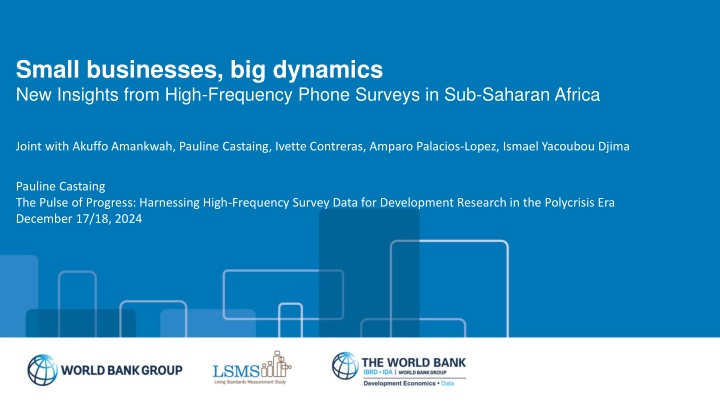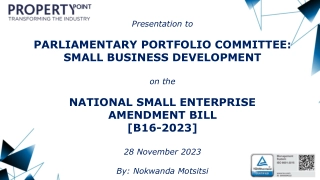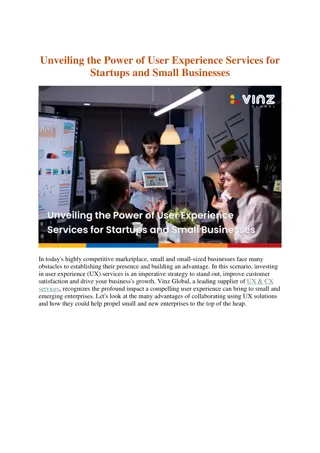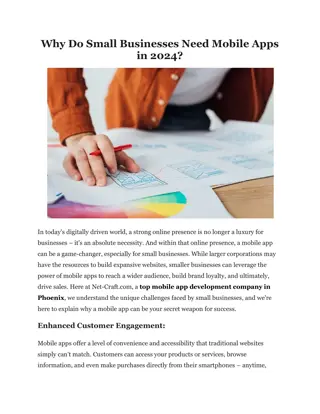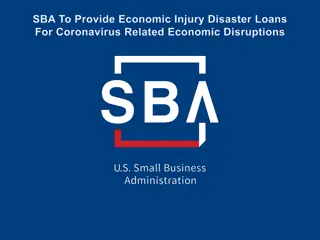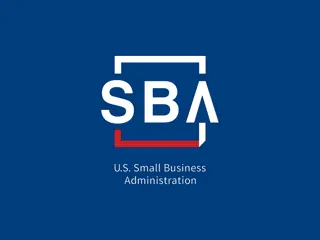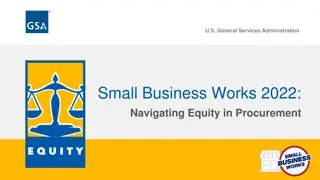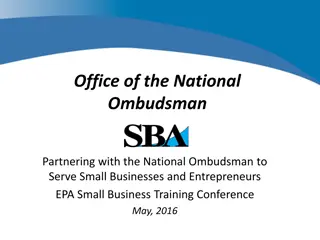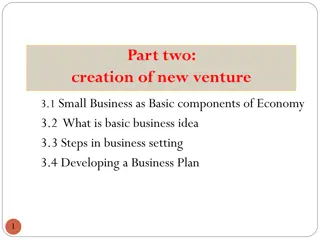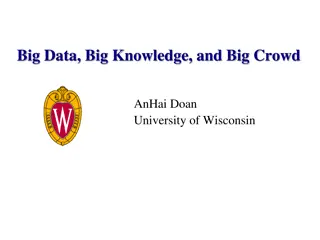Small businesses, big dynamics
Small businesses in developing countries face challenges due to limited financial resources, exposure to global and regional crises, and lack of systematic data collection. This study focuses on the dynamics of small non-farm businesses in Sub-Saharan Africa, providing insights on their prevalence, characteristics, and resilience during the COVID-19 pandemic and beyond. The research utilizes high-frequency phone surveys to gather data on firm operations and survival strategies, contributing to the understanding of crisis impacts on small businesses in low-income countries.
Uploaded on Mar 14, 2025 | 2 Views
Download Presentation

Please find below an Image/Link to download the presentation.
The content on the website is provided AS IS for your information and personal use only. It may not be sold, licensed, or shared on other websites without obtaining consent from the author.If you encounter any issues during the download, it is possible that the publisher has removed the file from their server.
You are allowed to download the files provided on this website for personal or commercial use, subject to the condition that they are used lawfully. All files are the property of their respective owners.
The content on the website is provided AS IS for your information and personal use only. It may not be sold, licensed, or shared on other websites without obtaining consent from the author.
E N D
Presentation Transcript
Small businesses, big dynamics New Insights from High-Frequency Phone Surveys in Sub-Saharan Africa Joint with Akuffo Amankwah, Pauline Castaing, Ivette Contreras, Amparo Palacios-Lopez, Ismael Yacoubou Djima Pauline Castaing The Pulse of Progress: Harnessing High-Frequency Survey Data for Development Research in the Polycrisis Era December 17/18, 2024 GPS FOR AREA MEASUREMET
2 Background Small businesses in developing countries: Prevalence o Small businesses employ a majority of non-agricultural workers (Hsieh & Olken, 2014) o Serve as critical source of income for millions of households, especially in rural settings Characteristics o Often informal, family-operated, and home-based (Nagler & Naude, 2017) o Small-scale, low-productivity, and low survival rate (McKenzie and Paffhausen , 2019) Challenges o Limited financial resources, poor access to financial services, and insufficient capital hamper their ability to recover from shocks (De Mel et al., 2012; Caballero-Morales, 2021) Exposure of small businesses to recent global and regional crises: Global shocks o COVID-19 pandemic exposed financial and operational vulnerabilities in small businesses o Disruptions led to significant declines in sales and uneven recovery trajectories (Apedo-Amah et al., 2020) Regional challenges o Ongoing conflicts in countries such as Burkina Faso, Ethiopia, and Nigeria o Rising commodity prices and financial pressures due to the 2022 Russian invasion of Ukraine (Amankwah et al., 2024) December 2024 HFPS Conference
3 Motivation and Contribution Key issues: Small businesses are rarely tracked in low-income countries due to infrequent and inconsistent data collection Limited systematic and recent evidence on small business patterns, prevalence, and performance in fast- changing environments This study: Large-scale and cross-country study informing about the dynamics of small non-farm businesses in Sub-Saharan Africa during the COVID-19 pandemic and its aftermath Data: longitudinal and high-frequency phone survey data from six countries covering a period 2020 to 2024, including detailed questions on the operational status of firms at the time of the survey Two main contributions: Adds to the literature on the dynamics of small non-farm businesses in Sub-Saharan Africa o Non-farm self-employment activities in the African households are mostly oriented around survival (Christiaensen, 2017) o As crises deepen and the need for support grows, it is crucial to understand how these small businesses survive and cope with shocks Adds to the debate on the benefits of using high-frequency data for real-time monitoring of crisis impacts o Recent studies used data from earnings reports (Hassan et al., 2020) and transaction records from credit and debit card purchases (Chetty et al., 2020) to highlight the negative effects of the COVID-19 shock on firm revenue and employment o Such data and tools are often unavailable in low-income countries, where businesses are characterized by a large informal sector (Ulyssea, 2020) and difficult to monitor December 2024 HFPS Conference
5 Data and Variables High-Frequency Phone surveys Administered in 6 Sub-Saharan African countries: BFA, ETH, MWI, NGA, TZA, and UGA Panel dataset with 4 years coverage: from 2020 to 2024 Uniform approach for questionnaire design, sampling, weighting, and fieldwork implementation Countries are part of the LSMS Integrated Survey on Agriculture (LSMS-ISA): access to pre-HFPS variables Harmonized LSMS-HFPS dataset available on github : github.com/lsms-worldbank Variables Household Enterprise: Any non-farm business operated in the household since last interview Current operational status of the business (active, temporarily closed, permanently closed) Self-Reported Shock since last interview: Income shock (loss of an income-earning member or loss of job) Price shock (changes in input or output prices) December 2024 HFPS Conference
6 Household participation in non-farm enterprises (1/2) Figure: Weighted share of households engaging in non-farm enterprises over time and space From 2020 to 2024, household entrepreneurship in Sub-Saharan Africa remains high o 60% in BFA, 47% in ETH, 49% in MWI, 68% in NGA, 56% in TZA, 40% in UGA Notable increase in participation to household enterprises during the early phases of the COVID-19 pandemic o Mobility restrictions severely disrupted economic activity (Palacios-Lopez et al., 2021; Contreras-Gonzalez et al., 2021) o Job losses likely fueled the growth of home- based income-generating activities December 2024 HFPS Conference
7 Household participation in non-farm enterprises (2/2) Question: Is the post-COVID-19 rise in household enterprise operations driven by income shocks experienced during the pandemic? Model: We use the first HFPS round with data on shocks, pre-HFPS NFE status, and estimate a linear probability model with OLS: ???_????????? ? = ?0+ ?1???_?????????_???????? + ?2 ??????_? ??? ?+ ?3 ??????_? ??? ? ???_?????????_???????? + ? ? ?+ ? ? ALL BFA MWI NGA UGA nfe operation pre-covid19 0.343*** 0.328*** 0.361*** 0.275*** 0.390*** Main result: (0.013) (0.025) (0.026) (0.026) (0.022) Income shock 0.110*** 0.151*** 0.040 0.157*** 0.035 Result for ?2: HHs that were not engaged in household (0.024) (0.046) (0.050) (0.047) (0.045) -0.129*** -0.146*** -0.057 -0.175*** -0.058 nfe operation pre covid ## enterprise prior to COVID-19 and faced an income income shock (0.031) (0.056) (0.071) (0.059) (0.067) Constant 0.358*** 0.436*** 0.325*** 0.291*** 0.205*** shock are more likely to start operating a business (0.024) (0.043) (0.041) (0.039) (0.032) Country fixed effects YES o Starting a business can serve as a coping Observations 7,541 1,860 1,644 1,950 2,087 R-squared 0.147 0.144 0.162 0.080 0.161 mechanism for households facing income shocks Robust standard errors in parentheses. *** p<0.01, ** p<0.05, * p<0.1. Covariates (household size, sector, and household head dummy) are included in all models. December 2024 HFPS Conference
8 How much household enterprise closure is there? (1/4) Figure: Weighted share of businesses that are closed December 2024 HFPS Conference
9 How much household enterprise closure is there? (2/4) Method to estimate monthly closure of household enterprise: Firm closure is defined as the transition from being open or temporarily closed at one point in time to being reported as permanently closed in the subsequent survey round Alternative 1: all temporarily closed businesses as permanently closed (upper bound) Alternative 2: permanent business closure are considered temporary if business activity is observed in next round (lower bound) We calculate firm closure rates for each of the 117 survey-time interval combinations in our data Months 1 Burkina Faso 1% Malawi 13% Nigeria 2% Tanzania 12% Uganda 3% Plot the firm closure rates for each survey-period combination [ 1% , 27%] 0% [ 10% , 44%] 13% [ 2% , 25%] 7% [ 8% , 34%] 11% [ 3% , 26%] 5% 2 [ 0% , 45%] 1% [ 11% , 36%] 16% [ 4% , 33%] 7% [ 7% , 45%] 15% [ 4% , 28%] 8% Estimate a linear model to explore the relationship between firm closure 3 [ 1% , 44%] 0% [ 15% , 37%] 21% [ 6% , 28%] 11% [ 8% , 45%] 20% [ 8% , 27%] 17% 4 rates and time [ 0% , 49%] 2% [ 20% , 42%] 32% [ 10% , 29%] 11% [ 17% , 37%] 23% [ 16% , 35%] 10% 5 [ 2% , 39%] 1% [ 32% , 70%] 24% [ 11% , 29%] 12% [ 19% , 50%] 23% [ 10% , 27%] 14% 6 [ 1% , 44%] [ 23% , 45%] [ 11% , 29%] [ 21% , 39%] [ 13% , 33%] 7 2% 39% 13% 12% [ 2% , 32%] 1% [ 39% , 71%] 28% [ 12% , 28%] 13% [ 11% , 39%] 15% 8 27% [ 1% , 44%] 2% [ 27% , 54%] 40% [ 13% , 29%] 14% [ 21% , 46%] 30% [ 14% , 32%] 15% 9 [ 2% , 30%] [ 40% , 68%] [ 14% , 25%] [ 26% , 44%] [ 15% , 32%] December 2024 HFPS Conference
10 How much household enterprise closure is there? (3/4) Table: Linear trends in household's NFE closure rate Figure: Estimated closure rates over different time horizons ALL BFA MWI NGA TZA UGA Months 0.016*** 0.001* 0.015*** 0.012*** 0.009*** 0.017*** (0.003) (0.001) (0.005) (0.001) (0.001) (0.001) Constant 0.063 0.005 0.158*** 0.040*** 0.152*** 0.080** (0.048) (0.003) (0.038) (0.009) (0.023) (0.033) Observations 117 36 13 12 17 39 R2 0.159 0.288 0.488 0.910 0.823 0.796 Annual exit rate 19% 1% 18% 14% 11% 20% In the pooled regression, standard errors are clustered at the country level. *** p<0.01, ** p<0.05, * p<0.1. December 2024 HFPS Conference
11 How much household enterprise closure is there? (4/4) Figures: Heterogeneity in monthly firm closure rate by pre-Covid NFE engagement and by sector (rural/urban) December 2024 HFPS Conference
12 What are the dynamic correlates of firm closure ? (1/2) Model: NFE status can be modeled as a multinomial choice framework (McFadden, 1984; Ahituv and Kimhi, 2002) o Mutually exclusive status : the business is either currently active, temporarily closed, or permanently closed Our objective is to understand how different time-varying covariates influence the likelihood of each household's business falling into one of the three categories To achieve this, we apply a panel multinomial logit model with household fixed effects: ??????? ??= ?? ?+ ? + ??+ ? ? Reference group: the business is currently operating ? ?: income shock, price shock, the respondent is currently working in farming, the respondent is currently working in the wage sector, and the respondent is the household head. Year fixed effects are also included to the model. December 2024 HFPS Conference
13 What are the dynamic correlates of firm closure ? (2/2) Table: Relative risk ratios from multinomial logistic estimations POOLED SAMPLE Household enterprises temporarily shut down as a response to economic shocks, but they are not necessarily exiting the market permanently Temporarily closed Permanently closed Income shock 1.321** (0.170) 1.168 (0.130) 1.065 (0.070) 3.163*** (0.619) 2.801*** (0.358) 0.830 (0.131) 1.012 (0.241) 0.677 (0.215) 0.679*** (0.055) 1.198 (0.368) 1.121 (0.312) 1.047 (0.642) o HHs that experienced an income shock are more likely to temporarily close a business than keeping it active (MWI and NGA) Price shock o Income and price shocks are not associated with any risk of shutting down the business (both in the pooled and by country analysis) hhsize Work in wage sec Temporary closures are strongly correlated with the work status of the main respondent, but permanent closures show no correlation Work in agri sec resp_head o The relative risk of temporarily closing a business, as opposed to keeping it active, is higher if the main respondent currently works in the wage or agricultural sector Year FE YES YES Obs Number of pnl_id Standard errors clustered at the household level are in parentheses. *** p<0.01, ** p<0.05, * p<0.1. 3,187 1,269 3,187 1,269 o When farming or wage employment presents more opportunities or higher returns (due to seasonal opportunities or market conditions), households may temporarily pause their business operations December 2024 HFPS Conference
14 Summary and conclusions Main findings: Substantial engagement in household enterprises across Sub-Saharan Africa, with participation rates ranging from 40% in Uganda to 68% in Nigeria between 2020 and 2024 Engaging in non-farm businesses helps households to navigate income shocks like job loss caused by COVID-19 On average, small businesses permanently closed at a rate of 1.6% per month o Higher closure rates for households in rural areas and without pre-pandemic experience in NFE Temporary closures are used as a strategy to mitigate the impact of income shocks, whereas permanent closures are not correlated with the occurrence of shocks Survey-related lessons learned: HFPS are valuable to capture the fast-changing environments of Household Enterprises Collecting information on temporary closures helps to unpack some important dynamics December 2024 HFPS Conference
15 Stay connected with LSMS GET UPDATES Worldbank.org/lsms World Bank's Living Standards Measurement Study lsms@worldbank.org December 2024 HFPS Conference
Small businesses, big dynamics New Insights from High-Frequency Phone Surveys in Sub-Saharan Africa Joint with Akuffo Amankwah, Pauline Castaing, Ivette Contreras, Amparo Palacios-Lopez, Ismael Yacoubou Djima Pauline Castaing The Pulse of Progress: Harnessing High-Frequency Survey Data for Development Research in the Polycrisis Era December 17/18, 2024 GPS FOR AREA MEASUREMET
17 Module on Household enterprises December 2024 HFPS Conference
18 Rounds with a module on Household Enterprise Burkina Faso Ethiopia Malawi Nigeria Tanzania Uganda Fieldwork Sample Fieldwork Sample Fieldwork Sample Fieldwork Sample Fieldwork Sample Fieldwork Sample Round Round Round Round Round Round date size date size date size date size date size date size GHS-P EHCVM 2018-19 2,953 ESS 2018-19 4,277 IHPS 2019 1,726 2018-19 3,267 UNPS 2019-20 3,267 W4 1 1 1 Jun-20 1,968 1 Apr-20 3,249 1 May-20 1,729 Apr-20 1,950 1 Mar-21 2,739 Jun-20 2,227 2* 2* 2* Jul-20 1,860 2 May-20 3,107 Jul-20 1,646 2* Jun-20 1,820 Apr-21 2,421 2* Aug-20 2,199 3* 3* 3* 3* Sep-20 2,013 3 Jun-20 3,058 Aug-20 1,624 Jul-20 1,790 Jul-21 2,339 3* Sep-20 2,147 4* Nov-20 2,011 4 Aug-20 2,878 4* Sep-20 1,616 4* Aug-20 1,789 4* Sep-21 2,312 4* Nov-20 2,136 6* Jan-21 1,985 5 Sep-20 2,770 5* Nov-20 1,589 5* Sep-20 1,774 5* Dec-21 2,197 5* Feb-21 2,122 8* 7* 6* Mar-21 1,967 6 Oct-20 2,703 Jan-21 1,560 6* Oct-20 1,762 8* Aug-23 2,042 Mar-21 2,100 9* Apr-21 1,971 7 Nov-20 2,536 8* Mar-21 1,551 7* Nov-20 1,726 10* Feb-24 1,942 7* Oct-21 1,950 8* 12 Apr-22 1,847 8 Dec-20 2,222 9* Apr-21 1,545 Dec-20 1,723 8* Jun-22 1,881 17* Mar-23 1,642 9 Jan-21 2,077 11* May-21 1,541 9* Jan-21 1,706 9* Aug-22 1,871 19* Sep-23 1,851 10 Feb-21 2,176 12* Jun-21 1,533 10* Feb-21 1,699 10* Oct-22 1,668 21* Feb-24 1,832 11 Apr-21 1,982 11* Mar-21 1,680 11* Dec-22 1,665 13 Oct-22 2,876 13 Dec-21 2,922 12* Feb-23 1,783 18 14* 14 Dec-22 2,509 Oct-22 2,461 Sep-23 1,838 GHS-P 16 May-23 2,336 2023-24 3,145 16* Dec-23 1,795 W5 18 Oct-23 2,237 (*) include questions on the current status of the non-farm enterprise ( ) include question on shocks December 2024 HFPS Conference
19 Summary Statistics from HFPS Rounds Over Survey Countries Temporarily Closed NFE Permanently closed NFE Main resp in wage work Main resp in farm work Main resp is head Income shock Price shock Active NFE Urban HH size Mean 0.595 0.065 0.008 0.657 6.714 0.14 0.162 0.862 0.16 0.081 BFA SD 0.491 0.247 0.086 0.475 3.862 0.347 0.368 0.345 0.366 0.273 N 20946 9990 9990 20947 20945 19067 19067 20945 9674 9674 Mean 0.473 . . 0.71 4.516 0.354 0.305 0.795 . . ETH SD 0.499 . . 0.454 2.287 0.478 0.461 0.404 . . N 38716 0 0 38716 38716 38711 37912 38716 0 0 Mean 0.488 0.138 0.051 0.369 5.063 0.254 0.281 0.755 0.135 0.357 MWI SD 0.5 0.345 0.22 0.483 2.266 0.435 0.45 0.43 0.342 0.479 N 15934 6934 6934 15934 15930 15433 15433 15929 4830 4830 Mean 0.676 0.093 0.033 0.395 6.42 0.139 0.329 0.784 0.234 0.588 NGA SD 0.468 0.29 0.179 0.489 3.828 0.345 0.47 0.411 0.423 0.492 N 24802 13562 13562 24802 24798 24802 24802 24798 7924 7924 Mean 0.558 0.151 0.14 0.373 5.61 0.151 0.355 0.873 0.215 0.3 TZA SD 0.497 0.358 0.347 0.484 2.867 0.358 0.479 0.333 0.411 0.458 N 15978 7821 7821 15992 14050 13732 13732 14049 4550 4550 Mean 0.395 0.156 0.057 0.252 5.593 0.106 0.484 0.741 0.192 0.232 UGA SD 0.489 0.363 0.232 0.434 2.746 0.308 0.5 0.438 0.394 0.422 N 26764 10234 11787 27382 21062 27373 27373 19856 6165 6165 December 2024 HFPS Conference
20 Estimates of firm exit rate in the literature Study Country Datasets Type of firm Period Firm closure rate McKenzie and Paffhausen (2019) Nigeria Nigeria General Household Survey Household non-farm 0.5 years 12% McKenzie and Paffhausen (2019) Nigeria Nigeria General Household Survey Household non-farm 1 year 21% McKenzie and Paffhausen (2019) Nigeria Nigeria YouWiN! National Business Micro and small 1 year 35% Plan Competition Impact Evaluation Survey McKenzie and Paffhausen (2019) Malawi Malawi Business Registration Micro and small 1 year 12% Impact Evaluation Survey McKenzie and Paffhausen (2019) Uganda Uganda Women s Income Micro and small 1.5 years 34% Generating Support Impact Evaluation Survey Nagler & Naud (2017) Uganda LSMS Household non-farm 1 year 31% December 2024 HFPS Conference
21 Dynamic correlates of firm closure by country Table: Relative risk ratios from multinomial logistic estimations ALL BFA MWI NGA TZA Temporarily closed Permanently closed Temporarily closed Permanently closed Temporarily closed Permanently closed Temporarily closed Permanently closed Temporarily closed Permanently closed income_shock 1.321** (0.170) 1.168 (0.130) 1.065 (0.070) 3.163*** (0.619) 2.801*** (0.358) 0.830 (0.131) 1.012 (0.241) 0.677 (0.215) 0.679*** (0.055) 1.198 (0.368) 1.121 (0.312) 1.047 (0.642) 0.956 (0.126) 1.740*** (0.302) 1.058 (0.127) 2.934** (1.347) 3.075*** (0.514) 0.591* (0.162) 0.000*** (0.000) 0.000*** (0.000) 0.370 (0.330) 3.658*** (1.359) 6.664* (7.206) 0.000*** (0.000) 1.218*** (0.019) 1.080*** (0.010) 1.400*** (0.065) 4.643** (3.608) 3.435*** (1.096) 0.543*** (0.034) 0.633 (0.207) 0.937 (0.326) 0.981 (0.039) 1.482 (1.160) 4.614*** (1.029) 0.209*** (0.007) 2.715*** (0.852) 1.119 (0.292) 1.082 (0.147) 2.642*** (0.821) 2.042*** (0.446) 1.490 (0.802) 1.446 (0.570) 0.406* (0.211) 0.614*** (0.066) 0.710 (0.302) 0.529*** (0.090) 5.036 (7.074) 0.813 (0.222) 1.100 (0.266) 0.862 (0.240) 2.704** (1.121) 2.111*** (0.547) 2.991 (3.662) 0.641 (0.235) 1.971 (0.836) 0.822 (0.267) 1.689 (0.800) 1.281 (0.476) 2.062 (2.458) price_shock hhsize wage_cur farm_cur resp_head Year FE YES YES YES YES YES YES YES YES YES YES Obs Number of pnl_id Standard errors clustered at the household level are in parentheses. *** p<0.01, ** p<0.05, * p<0.1. 3,187 1,269 3,187 1,269 772 225 772 225 763 309 763 309 840 329 840 329 754 377 754 377 December 2024 HFPS Conference
22 How much household enterprise closure is there? (5/5) Reproduce similar estimates for Nigeria using GHS-Panel Waves 4 (2019) and 5 (2024) 54% of firms closed over a five-year period: annual closure rate of 11% Similar firm closure rate than the one estimated with HFPS (14%) BUT many inconsistencies in firm closure measurement across the two approaches Cross-survey comparison of household s firm status in HFPS and GHS-Panel in Nigeria Operated a business that survived during HFPS 48% 32% 20% Operated a business that closed in HFPS 35% 28% 37% 0% 10% 20% 30% 40% 50% 60% 70% 80% 90% 100% Survival between GHS-P W4 and W5 Closure between GHS-P W4 and W5 No business in GHS-P W4 December 2024 HFPS Conference
23 Bibliography Ahituv, A., & Kimhi, A. (2002). Off-farm work and capital accumulation decisions of farmers over the life-cycle: The role of heterogeneity and state dependence. Journal of Development Economics, 68(2), 329 353. Chetty, R., Friedman, J. N., Hendren, N., Stepner, M., & The Opportunity Insights Team. (2020). How did COVID-19 and stabilization policies affect spending and employment? A new real-time economic tracker based on private sector data. Working Paper No. 27431. National Bureau of Economic Research. Christiaensen, L. (2017). Agriculture in Africa telling myths from facts: A synthesis. Food Policy, 67, 1 11. Contreras, I., Oseni, G., Palacios-Lopez, A., Pieters, J., & Weber, M. (2021). The labor market impacts of COVID-19 in four African countries: April to October 2020 - Evidence from LSMS-supported high-frequency phone surveys on COVID-19. Washington, D.C.: The World Bank. Hsieh, C., and Olken, B. 2014. The Missing "Missing Middle". Journal of Economic Perspectives, 28 (3): 89 108. Nagler, P., & Naud , W. (2017). Non-farm entrepreneurship in rural Sub-Saharan Africa: New empirical evidences. Food Policy, 67, 175 191. McFadden, D. L. (1984). Econometric analysis of qualitative response models. In Z. Griliches & M. D. Intriligator (Eds.), Handbook of Econometrics (Vol. 2, pp. 1395 1457). Elsevier. McKenzie, D., & Paffhausen, A. L. (2019). Small firm death in developing countries. The Review of Economics and Statistics, 101(4), 645 657. Palacios-Lopez, A., Newhouse, D. L., Pape, U. J., Khamis, M., Weber, M., & Prinz, D. (2021). The early labor market impacts of COVID-19 in developing countries: Evidence from high-frequency phone surveys. Policy Research Working Paper Series 9510. Washington, D.C.: The World Bank. Ulyssea, G. (2020). Informality: Causes and consequences for development. Annual Review of Economics, 12, 525 546. December 2024 HFPS Conference
